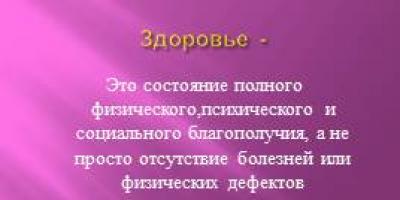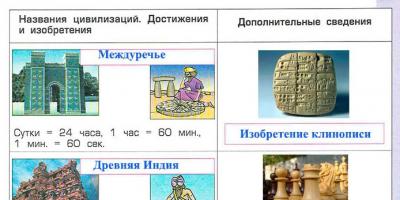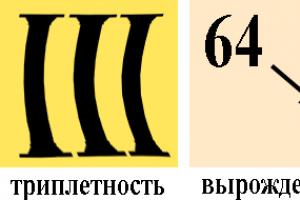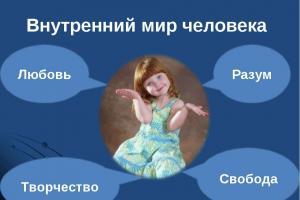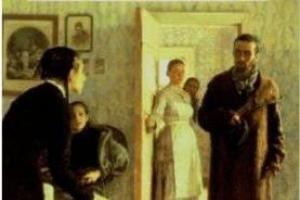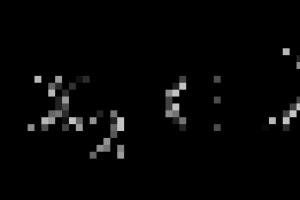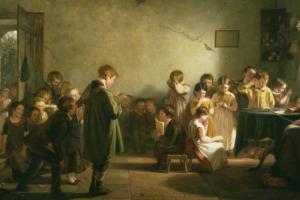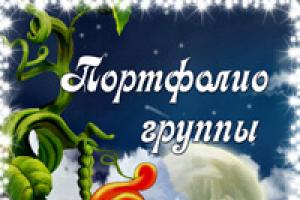1. Insert the missing words into the text.
era Ancient world is the birth of the first civilizations . The first began to appear cities. To organize and protect the lives of different people, it was necessary have laws, maintain an army, collect taxes . This is how they appeared states .
Continue the sentences.
People began to depend less on nature, as they learned to make tools from gland. Another important invention of this time was wheel. We still use many achievements of the Ancient world, for example: ability to handle and use fire for cooking and heating the home.
Determine and write in the table which of the ancient civilizations the given illustrations belong to. Using additional literature, fill in the second column of the table (draw or describe other features of civilizations).

2. Write in the crossword puzzle the names of ancient civilizations that are the inventors of the following achievements:
1. Alphabet of vowels and consonants (Hellas).
2. A calendar in which the year is 365 days (Egypt)
.
3. Familiar images of numbers from 0 to 9 (India)
.
4. Silk fabrics (China)
.
5. Latin language (Rome)
.
Add the word “Interfluve” to the crossword puzzle in any suitable place and write down the inventions of this civilization
6. First writing (cuneiform)
3. “Use Roman numerals to mark on the “river of time” (p. 31) the centuries of the Ancient World. Mark the years of the following events:
- 776 BC - the first Olympic Games in history;
- 74 BC - slave uprising led by Spartacus.
- These inventions of the ancient world influenced the development of mankind. Come up with a symbol that you understand for each invention and draw it in a frame, and then on the “river of time” in the right place.

The appearance of iron tools (end of the 2nd millennium BC)
Invention of the wheel (turn of the 3rd-2nd millennium BC) 
4. Complete the tasks on the contour map (see pages 84-85).
- Draw the border of the civilized world.
- Color the territories of civilizations of the Ancient World with different colors
 Write in which parts of the world the civilizations of the Ancient World are located.
Write in which parts of the world the civilizations of the Ancient World are located.
Africa. Asia. Europe
Emphasize the civilization that occupied a large area.
- The world of primitive tribes
- World of Ancient Civilizations
Come up with symbolic images of architectural monuments of the Ancient World (see pp. 54-55 of the textbook). Place them on the territories of those civilizations where these structures were built.
 5. Look carefully at the pictures. What do you think ancient people would have done? Draw or write a continuation of this story from the moral point of view of the Ancient World.
5. Look carefully at the pictures. What do you think ancient people would have done? Draw or write a continuation of this story from the moral point of view of the Ancient World.

Most likely, the inhabitants of the Ancient world would have caught a captured stranger and turned him into a slave. They believed that people of other cultures are not civilized people, that they are savages. Therefore, they were sure that they could only be slaves.
Continue the sentence.
Position (opinion) I wouldn't want to be treated the same way
Argument(s) because I am a free civilized person and I need to be treated as an equal person
.
Think about what you, a person of the 21st century, would do in a similar situation. Draw or write a continuation of this story from the point of view of a modern person.

In the modern world, in such a situation, you need to contact the police so that the thief is detained and the suitcase is returned to the tourist. In modern society, the law applies to all people equally. It doesn’t matter whether it’s a visitor or one of our own, in any case he is under the protection of the law.
Draw a conclusion.
Position (opinion) I believe that modern people must treat all people with respect, regardless of their nationality, race or religion.
Argument(s) because then people will be able to travel around the world and not fear for their safety.
How does the era of the Ancient World differ from the era of the Primitive World?
Read the topic of the lesson again.
Do you understand all the words?
What word do you not understand? (civilization)
To find out what civilization is, open the textbook on page 53. Read paragraph 2.
Civilization is the emergence of the first cities, settlements of artisans, traders and rulers, and the emergence of the state.
Below there is a drawing “The transition from primitive society to civilization.”
- Now you will work in pairs.
Looking at this diagram, try to write a story.
That is name the main features by which civilizations differ from primitive societies. (examination)
So, in the era of the Ancient World, cities, states, and writing appeared. These are the main signs of civilization.
Physical education minute
Let's look at the map p.55-54
What is indicated on the map by the wide pink line?
What is beyond this border?
Which world is more extensive - the world of primitive tribes or the world of ancient civilizations?
What is marked with different colors on the map?
What civilizations are located in Europe?
What are the civilizations of the Ancient East?
Where exactly was each ancient civilization located?
Row assignment:
1. look at the map and compare architectural monuments
2. look at the map and compare the writing of different countries (picture on the board)
3. look at the map and compare clothes from different countries (on the interactive board)
Draw a conclusion
Suggestive questions:
Are the architectural structures similar to each other?
Compare the clothes of people of different Ancient civilizations.
What can you say about the clothes?
Compare writing
- What can be concluded?
We compared with you architectural monuments, clothing, and writing. And what conclusion did you come to?
Let's try to give a second definition to the word “civilization”.
Let's check p.53 (3rd paragraph)
Now let's find out what objects really came to us from the Ancient World?
- Ancient Egypt -The Egyptians were the first to create a calendar in which a normal year consists of 365 days.
Ancient Mesopotamia.Standing on top of the temples, people studied the starry sky, the movement of the Moon and the Sun. It was they who first divided the day into 24 hours, an hour into 60 minutes, and a minute into 60 seconds. This is how the time counting system we now use was created.
Ancient India.Scientists were the first to create signs to designate the numbers we use 0,1,2...9.
Ancient China.The masters of Ancient China became famous throughout the world for their light, elegant fabrics. For many centuries they kept the method of making them secret.
Ancient Greece - Hellas.In its coastal trading cities, an alphabet of vowels and consonants first appeared. Most modern alphabets are based on it.
Ancient Rome.The language of the Romans - Latin was known in all his possessions. We now use Latin words: church, university, empire, calendar, etc. In our calendars, the names of the months come from the names of Roman gods or emperors (March - the god Mars, July - Julius Caesar)
But in the era of the ancient world, technology also developed. Pay attention to p.57.
Compare the technical capabilities of people in the ancient world and the primitive world.c 50 and c. 57.
What can you say?
In the ancient world, an iron ax, a wheel, and sailing and rowing ships appeared.
What technical achievements of the ancient world helped people move long distances?
Sailing on sailing and rowing ships, it was possible to make long voyages and not be afraid of overseas travel. Troops on war chariots could travel long distances and suddenly attack the enemy. If we compare the tools of labor, then in the ancient world an iron ax appears. It took a whole day to cut down a tree with a stone axe, but with an iron ax it could be done in a few minutes.
Thus, technological achievements in the ancient world rose to a higher level of development.
Turn the page, read the text.
Answer the question: what was considered good and what was evil in the era of the Ancient World?
Kokoreva Tatyana Ivanovna
Job title: primary school teacher
Educational institution: MBOU "Secondary School No. 1"
Locality: Kasimov city, Ryazan region
Name of material: lesson plan on the world around us in 4th grade
Subject:“The ancient world is the birth of the first civilizations. Main events of the Ancient world. The birth of the Olympic Games."
Publication date: 14.12.2018
Chapter: elementary education
Public lesson
around the world
in 4th grade
Subject: " The ancient world – the birth of the first civilizations. Basic
events of the Ancient world. The birth of the Olympic Games."
Lesson objectives:
1. Mastery of the picture of the world: teach to distinguish the era of the Ancient One from other eras
world, teach to find phenomena, discoveries and achievements in modern life,
preserved from the times of the ancient world.
2. Understanding the connection between ancient and modern Olympic Games
3. Formation of patriotic feelings: love for the Motherland, pride in our
champions, the desire to be like them.
1. Communication:
working with various types of information
2. Cognitive:
establishing cause-and-effect relationships
choosing the most effective ways to solve a problem
subsequent reflection of the chosen methods
3. Regulatory:
predicting the topic of the lesson
lesson goal setting
volitional self-regulation during independent work
awareness of the quality and level of learning material
Lesson form: binary lesson.
Teachers: Kokoreva T.I. – primary school teacher, Shestakova V. E. –
a history teacher.
Lesson summary
1.Repetition of what was learned in the previous lesson.
Teacher: - Last lesson, we began to study the topic “The Ancient World - the Birth
first civilizations."
Let's remember the basic concepts.
1) Name the time period of the era of the Ancient World. (3rd millennium BC – 5th century
new era)
2) What does the term “civilization” mean? (A higher stage of development of society.)
3) Name the signs of civilization (A state emerges with a government, laws,
army. People live in cities. Writing appeared.)
2. Announcing the topic of the lesson
- Modern people know not only the achievements of the civilizations of the Ancient world, but also
remember the events of those distant times. Today we will talk about bright events
The ancient world, which continues in our time.
3. Statement of the problem.
Games. There is probably no person on earth who would be indifferent to the Olympic Games.
games. Story
Olympic
amazing
attract the attention of poets, writers and scientists. The Olympic Games are precisely the arena
where a person once again confirms that there are no limits to human capabilities.
It is no coincidence that the Olympic motto is “Faster, higher, stronger!” "(poster)
And the main symbol of the Olympics is the Olympic white flag with five rings.
Each ring has a different color and represents a continent. (poster with rings on magnetic
How many of you can name the meaning of the color of the Olympic rings?
Blue - Europe, black - Africa, red - America, yellow - Asia, green -
Australia. Five intertwined rings are a symbol of the holiday of peace and friendship.
Why do you think athletes' competitions are called Olympic
games? Who invented the Olympics? Where and how Were the first Olympic Games held?
4. Finding a solution to the problem (discovery of new knowledge)
History of Olympic Games. – Shestakova V.E.
Vera Evgenievna: Guys, let's now go back to those ancient times, where
it all started.
In the southern part of Greece in the Peloponnese is the city of Olympia - the place where the
first Olympic Games.
The gods of the ancient Greeks lived on the sacred Mount Olympus. They were organized in their honor
Olympic Games
Hundreds of participants and thousands of spectators from all cities of Greece gathered in Olympia.
The first Olympic Games took place in 776 BC(write in notebook).
From this date the Greeks calculated their chronology. But what caused them?
appearance?
One legend attributes the honor of founding the games to Zeus himself. Elis was ruled by cruel
God Kronos. Out of fear of dying at the hands of one of his children, he swallowed
newborn babies. Goddess Rhea, having given birth to another son, gave his father wrapped in
in diapers a stone, which he swallowed without noticing the substitution, and the newborn Zeus
entrusted to the shepherds. The boy grew up, entered into a mortal battle with Kronos and won
his. In honor of this event, Zeus founded sports competitions.
In the year of the Olympic Games, heralds spread the good news throughout the cities of Hellas: “Everything is in
Olympia! Sacred peace has been declared, the roads are safe! May the best win."
What new can we learn from this call?
All Greek cities took part in the Olympics.
During the Olympics, wars stopped. On pain of damnation and
Due to the disfavor of the gods, no one could appear in Olympia with weapons. Even robbers and
pirates did not attack travelers.
The games were fair
competitions
accept
free
women
It was forbidden to be present even as spectators.
Married women were not allowed to attend the Games on pain of death. Only once this
the rule was broken. Who could take such a risk?
They said that one brave Greek woman, wearing men's clothing, secretly entered
Olympia to watch his son perform. When the young man won, his mother
she rushed to him in delight, and everyone realized that she was a woman...
Teacher: What do you think happened to this woman? (The unfortunate woman should have
executed, but out of respect for her son, the winner, was pardoned.)
Almost a year before the start of the Olympic Games, all participants were required to begin
training
tirelessly
athletes were practicing. And exactly a month before the opening of the games they were supposed to arrive in South
Greece and near Olympia to continue preparations. Game participants usually
wealthy people became wealthy, but the poor could not train for many months. In
During the Olympic Games, warriors were banned and a truce was declared.
And now it’s time to find out how the Olympic Games were held and what their
program.
Five unforgettable days.
The Olympic Games took place in the summer and lasted five days.
Five unforgettable days of the Olympics:
First day. The athletes made sacrifices to the gods and swore an oath to fight honestly. Judges
swore to make fair decisions.
Competition oath
I, Corebus, son of Pares, an Athenian, confirm before Zeus that I have trained as
This is required by the ancient traditions of the great holiday. I solemnly swear that
To achieve victory, I will not use unworthy techniques in competition.
Judges' oath
We, the judges, promise on oath that we will make our decisions honestly and incorruptibly.
Let us look at photographs of archaeological finds. These are ancient vases
Greeks, there are drawings on the vases. Your task is to find out what types of sports
were in ancient Greece.
Judging by the drawings on the vases, the athletes were engaged in running, wrestling, and discus throwing.
On the second day Competitions were held in the boys' group.
Third, fourth day were devoted to competitions. One of the main competitions
The Olympic Games were pentathlon.
Pentathlon is a competition of one person in five sports.
The pentathlon begins with running.
The next type of competition was the long jump. To increase length
During the jump, athletes used dumbbells made of stone or metal weighing up to 2 kg. ,
20 cm long. At the moment of the jump, the arms with dumbbells were thrown out in front.
Discus and javelin throwing competitions were held on the running track.
The last competition in the pentathlon was wrestling, where strength and agility were demonstrated.
wrestlers. It was carried out on the sand. Before the start, the athletes rubbed their bodies with olive oil.
oil to make it more difficult for the enemy to grab it. To win it was necessary
so that the opponent touches the ground three times with his shoulder, hip or back.
All types of competitions took place at the stadium, but one type of competition, the most
exciting, took place at the hippodrome (place for competitions) is
chariot races. At great speed, chariots drawn by fours
horses rushed around the hippodrome arena. Twelve times it was necessary to rush across
circle, overtaking rivals.
In the fifth final day in front of the Temple of Zeus a table made of gold and ivory was placed
bones. There were awards on it.
Reward
winners
Winners
approached the chief judge and received well-deserved awards. The herald announced the name
the athlete and called his hometown, and the spectators enthusiastically shouted: “Glory to the winner!”
Competitions
were ending
were returning
winners.
The Olympic Games took place 293 times in Ancient Greece.
Today you learned a lot about the Olympic Games. Let's check how
well you remember everything.
Vera Evgenievna asks the children questions orally. Children raise torches if approval
Z assignment:“True or false?” What errors are contained in some sentences?
1. The Greeks dedicated the Olympic Games to the god Zeus. (Yes)
2. The first Olympic Games took place in 750 BC. (No)
3. With the onset of winter, the Olympic Games began at the foot of Mount Olympus. (No)
4. The Olympic Games were held over 4 days. (No)
5.Only men could participate in the games. (Yes)
6. The Olympic Games were held at Mount Olympia. (Yes)
7. The winner of the Olympic Games was awarded an olive wreath intertwined with a white ribbon.
8. Military actions were allowed during the Olympic Games. No
But in 394, when Greece was under the rule of Rome, the Roman emperor
Theodosius I banned the Olympic Games as pagan. A few years later he
ordered
the buildings
fully
destroyed
once a thriving city.
When were the Olympic Games revived again?
5. Modern Olympic Games.
Presentation “Olympic Symbols” with commentary.
The revival of the Olympic movement is associated with the name of Baron Pierre de Coubertin -
French historian, writer, teacher and social and political figure. IN
In 1894, the International Sports Congress, at his proposal, decided to
creation of the International Olympic Committee and holding in 1896 I
Olympic Games following the example of the ancient ones. In 1913, Olympic symbols appeared in
in the form of 5 intertwined rings and a sacred fire, which is traditionally lit in Greece.
Olympics in Moscow. (briefly)
In 1980, when our country was called the USSR, 22 summer
Olympic Games
Athletes from many countries of the world came to us and played
medals in 21 sports. The symbol of the Olympics was a bear.
B) Olympics in Sochi.
In February 2014, the 22nd Winter Olympic Games were held in Sochi, Russia. All
Russia was rooting for our Olympians and was proud of them. We started the morning with hot
dialogues about the previous day of the Olympics, and after school they ran home to the screens
TVs to see and learn about new victories of our champions. They were bright and
happy days for both children and adults! Sochi Olympics for preparation and
organization surpassed all previous Olympics. This is the great merit of our
President V.V. Putin. Here's how I responded about it Denis Matsuev, pianist, folk
Russian artist: “The impressions are phenomenal. I've been to 6 Olympics, I have a lot to offer
compare. This has never happened anywhere: neither such sports tracks, nor such volunteers, nor
unique sports facilities, no attitude towards competition participants, no
atmosphere in stadiums. All the days we were beside ourselves with happiness.”
And here is how Olympic champion in cross-country skiing Alexander Legkov responds: “When I
flew to Sochi, just opened my mouth in surprise - how is it possible to build such
wonderful stadiums! The organization was at such a high level that it’s true
I believed that this was not a dream. I have been to other Olympics, compared to Sochi -
kindergarten
Our athletes won the Olympics with an absolute record: 33
medals, including 13 gold, 11 silver, 9 bronze.
Pay attention to the table “26 Russian Olympic champions
Sochi 2014".
C) Projects studying the Russian champions of Sochi 2014.
On the display board - exhibition of student projects about Russian medalists
Sochi Olympics.
You have prepared projects about the Russian medalists of this Olympics. Which one are you talking about?
want to tell? (2-3 students go to the board and talk about their champion,
photos are shown).
D) Viewing a presentation about the Russian champions of Sochi
Olympics.
6. Lesson summary
How did the Olympic Games of the Ancient World influence the modern Olympic Games?
- What do the ancient and modern Olympic Games have in common?
1. The purpose of the Olympics: to measure strength in sports competitions.
2.peaceful character
3. lighting of the Olympic flame,
4. symbols,
6. oath of game participants
7. judges’ oath of impartial judging,
8.time interval between the Olympics (4 years).
9. Awarding the winners
26 RUSSIANS - OLYMPIC CHAMPIONS SOCHI-2014
Gold
Athlete
Kind of sport
Viktor An
short track
Alexey VOEVODA
bobsled
Tatiana VOLOSOZHAR
figure skating
Alexander ZUBKOV
bobsled
Maxim TRANKOV
figure skating
VIC WILDE
snowboard
Ekaterina BOBROVA
figure skating
Alexey VOLKOV
biathlon
Vladimir GRIGORIEV
short track
Semyon Elistratov
short track
Ruslan ZAKHAROV
short track
Elena ILINYKH
figure skating
Nikita KATSALAPOV
figure skating
Fedor KLIMOV
figure skating
Alexander LEGKOV
skis
Yulia LIPNITSKAYA
figure skating
Dmitry MALYSHKO
biathlon
Alexey NEGODAILO
bobsled
Evgeniy Plushchenko
figure skating
Dmitry SOLOVIEV
figure skating
Adeline Sotnikova
figure skating
Ksenia STOLBOVA
figure skating
Alexander TRETYAKOV
skeleton
Dmitry TRUNENKOV
bobsled
Evgeniy USTYUGOV
biathlon
Anton Shipulin
+ [Read the topic of the lesson]
Lesson topic: “The Ancient World - the Birth of the First Civilizations”
What interesting thing did you notice in the title of the lesson topic? Do you understand all the words? (We don’t know what civilization is)
Vocabulary work (reading a new word in parts and together, observing the emphasis). A sign with a new word is hung on a magnetic board.
civilization civilization
Can you define the word "civilization"? Open the textbook on p.53. There is a drawing below. "The transition from primitive society to civilization." Looking at this diagram, try to compose a story according to plan.
Plan.
1. Where did people of primitive society and civilization live?
2. Who controlled the people?
3. How were messages and knowledge transmitted?
You will work in groups.
Work in groups on cards.
Card No. 1
People of primitive society lived in ……………. .
The people were governed by the elder ………….. .
Messages and knowledge were transmitted to …………….. .
Card No. 2
People of civilization lived in ………………. .
People were controlled by ………….. .
Messages and knowledge were transmitted using …………. .
The answers are listened to.
Let's read the topic of the lesson again.
How does the era of the Ancient World differ from the era of the Primitive World? (Cities, states, writing appear)
On the board under the question a sign is placed “cities, states, writing appear”
Guys, look, what is the shape of the pink line? (Shaped like a step)Teacher: Try to give a definition, complete the phrase.
Civilization is……a stage of human development.
Let's check our assumption with the textbook. Read p.53, paragraph 2. Find the definition of civilization. (New, higher stage of human development)
So, in the era of the ancient world, cities, states, and writing appeared. These are the main signs of civilization.
On the deska sign appears under the first question
+ But the word "civilization" has another definition.
Open the textbook on pp. 54-55, let's look at the map.
Look at the symbols on the map.
What is marked with different colors on the map? (Ancient civilizations)
+ What civilizations are located in Europe? (Ancient Rome, Ancient Greece)+ What are the civilizations of the Ancient East?( Ancient Egypt, Mesopotamia, Ancient China, Ancient India)
+ note, Where exactly was each ancient civilization located? (along the banks of rivers, seas)
+ The civilizations of Ancient Europe were located along the shores of the Mediterranean Sea, and the civilizations of the Ancient East were located along the banks of large rivers: the Nile, Tigris, Euphrates, Indus, Yellow River and Yangtze.
Look at the illustrations that are placed around the map. Name the civilizations and architectural monuments for which they became famous.
+ Are the architectural structures similar to each other? Why? (No, everyone is different, because different countries, different cultures)
+ Compare the clothes of people of different Ancient civilizations. What can you say about the clothes? Why? (No, everyone is different, because different countries, different cultures)+ Compare writing. What can you conclude?( Each country has its own writing system. Different countries, different culture).
We compared with you architectural structures, clothing, and writing. So what conclusion can you come to? (Each civilization had its own special culture)+ So what is civilization? Let's try to give a second definition to this concept. Finish the sentence.Civilizations are different……..with their own special…….
Teacher:Let's check our assumption in the textbook p.53, paragraph 3.
On the deskunder the first question a sign appears withsecond definition.
Guys, what question did we answer?(What is the difference between the era of the Ancient World and the era of the Primitive World?)
+ What question do we still need to answer? (Which of the presented objects appeared in the era of the ancient world?)+ We can find the answer on p.56. Review the table. "Inventions of civilizations of the Ancient World."
+ But in the era of the ancient world, technology also developed. Pay attention to the figure “Inventions of Civilizations of the Ancient World” on p. 57.
What did people invent in the ancient world? (The iron ax, wheel, sailing and rowing ships appear in the Ancient World)+ What technical achievements of the ancient world helped people move long distances?( Chariots, sailing and rowing ships)+ Sailing on sailing and rowing ships, it was possible to make long voyages and travels. Troops on war chariots could travel long distances and suddenly attack the enemy. The appearance of the iron ax made people's work easier. It took a whole day to cut down a tree with a stone axe, but with an iron ax it could be done in a few minutes. Thus, technological achievements in the ancient world rose to a higher level of development.+ What question did we answer?( Yes) Under the question “Which of the presented objects appeared in the era of the ancient world?” a sign appears
Read the topic of the lesson. What questions did we answer today?
Purpose of the lesson: to introduce the era of the Ancient World, the signs of a state, and the concept of civilization.
The lessons use research technology, project method, and group work. When studying Ancient civilizations (Egypt, China, India, Greece, Rome), newspapers are created with brief information about each: management, achievements, attractions.
Download:
Preview:
Technological map of the lesson:
“The Ancient World – the Birth of the First Civilizations.”
4th grade
Program : “School 2100”, “The world around us”, Vakhrushev A.A., Rautian A.S.,
“World and Man”, M., “Balass”, 2000.
Lesson type: combined
Lesson objectives:
Cognitive:
- Introduce the era of the Ancient World, the signs of a state, and the concept of civilization.
- Develop the ability to create educational projects
Educational:
- Develop the ability to work with a historical map in a textbook and a contour map in a notebook.
Educational:
- Develop an interest in history and broaden your horizons.
UUD:
Personal: the formation of value guidelines for the formation of a respectful attitude towards the history of peoples.
Regulatory: independently formulate the purpose of the lesson after a preliminary discussion, the ability to independently plan one’s actions when preparing a message on a given topic, the ability to work according to a given algorithm.
Cognitive: explain the life of people of the ancient world from the point of view of their morality, process the information received from one handicap to another, present the information in the form of a table.
Communicative:the formation of a respectful attitude towards other opinions, the ability to negotiate, perform various roles in a group, and cooperate in jointly solving a problem.
Form of organization of cognitive activity: frontal, group, individual.
Security:
- computer, multimedia projector, screen.
- presentation.
- textbook, contour maps.
- materials for group work
Note: The project method requires extensive preparation of the teacher and students. Students in the class are divided into 5 groups.
Each of which offers material about one of the ancient civilizations. The teacher corrects the students’ work and helps them draw up a plan for defending the project. During the lesson, each group talks about one of the civilizations, as well as showing illustrations from encyclopedias and other sources of information.
Teacher: Semenova Svetlana Vladimirovna
During the classes.
Lesson stage, goal | Use of digital educational resources |
||
1. Self-determination for activity (Psychological attitude to the lesson. Conditions are created for the student to have an internal need to be included in educational activities) | Guys! I'm very glad to see you. Look out the window: today is a cloudy (sunny) day. Let's let the sunshine into our classroom! How can I do that? (smile) Smile at the neighbor on your right Smile at the neighbor on your left. If you just smile, Then miracles will begin - Smiles will make you clearer Both eyes and heaven. Come on, dear guys, Smile quickly To become in our class Both lighter and warmer! | ||
2. Repetition of learned material - repeat the studied material, consolidate the knowledge and skills necessary for independent work on new material | In our last history lesson we talked about primitive people. Name the main activities of primitive people. How did modern man learn about how primitive people lived? What achievements do we still enjoy? | Students share material from the previous lesson: 1) People live in hunting camps or in small villages. 2) Society consists of clans and tribes in which there is no stratification into rich and poor. 3) Power belongs to the people's assemblies of the tribe, elders, and elected leaders. 4) Knowledge is transmitted through oral tales in the form of images. Archaeologists have found material evidence (tools, rock paintings) fire | Tables are posted on the board: Caves Hunting Community, leader Rock painting |
3. Introductory and motivational Prepare students to communicate and learn new material | In today's lesson we will continue our journey along the river of time. We are going to the Ancient World. This is a new step in the development of society. What do you think is the main goal and task of our lesson? Indeed, we will learn about the most ancient states, we will find out which country can be called a state. How do we know about an era that was 3 million years ago? We will also work with a historical map of the Ancient World, and get acquainted with the sights of ancient civilizations that have survived to our times. | Understand how the primitive world differs from the ancient one. From a textbook, from a teacher’s story, from encyclopedias, a computer | |
4. The stage of actual educational activity. Educational aspect of the lesson purpose. | Working with the textbook p. 53 How does ancient civilization differ from primitive society? | ||
As soon as a person learned to cultivate the land, grow plants and animals, he entered the next stage of his development Crafts appeared, cities began to be built, people appeared who controlled other people,transition from primitiveness to civilization. This happened around the middle of the 4th millennium BC ad. Look at the diagram and answer what is the beginning of the Ancient World? | Students observe the transition from primitiveness to the first civilizations according to the diagram The emergence of cities | Slide 1 |
|
Make guesses: what is “civilization”? The word "civilization" comes from the Latin word "civilis", which means "civil, urban, state". Those. “civilization” is an organization of people’s lives that is opposite to the wild state of life and rude human behavior. Civilizations are organized communities of people with a highly developed culture and religion. How does ancient civilization differ from primitive society? | Students, based on their life experience, make assumptions, the teacher offers a translation of the word, and leads them to the definition of the term. Students read the textbook text | Slide 2 Civilization Slide 3 The emergence of cities Slide 4 State Slide 5 Must have Slide 6 Writing Slide 7 |
|
Working with a contour map | Working with the map p. 54-55 Look at the legend Which states belong to the Ancient World? What will Ancient civilizations unite? Research by scientists has shown that the most ancient civilizations arose in the valleys of the largest rivers. Why do you think? Working with a contour map p. 84-85 Large masses of people flocked here to the fertile valleys. They created their own cities and settlements on their banks, which were then united into states. | Egypt, Mesopotamia, Rome, Greece, China, India Students speak out, and the most accurate guesses are written on the board. Students look at pictures of rivers, on a map, and mark the Tigris and Euphrates, Nile, Yellow River, Yangtze, Indus, and Ganges rivers on historical contour maps. | |
From the mountains of Armenia in the north to the Persian Gulf stretches a vast territory called Mesopotamia by the ancient Greeks, which means “the land between two rivers.” Indeed, Mesopotamia was located between two rivers: the Tigris and the Euphrates. | Schoolchildren fill out an outline map | Slide 8 Slide 9 First houses |
|
The Sumerians settled in the lower reaches of the Tigris and Euphrates. Translated from the ancient language, the word “Sumerians” meant “black-headed”. Why do you think these people called themselves that? | Schoolchildren mark the Sumerian state in red on the map and answer the question. | Slide 10 |
|
One of the mysteries of the history of the Ancient World is connected with the Sumerians. It is unknown where they came from to Mesopotamia. The Sumerian language is unlike any other. From surviving images we know that the Sumerians had oval faces with large eyes. It seems that these are aliens from other worlds. Both men and women wore skirts made of wool or leaves. Men shaved their heads and women wore beautiful headdresses. | |||
They made bricks from clay and built cities. Cities appeared on hills and were surrounded by walls, i.e. had certain territory and boundaries. At the head of the Sumerian cities wererulers (kings). The rulers published laws . These were the first laws in history. The city-state had its own treasury at the disposal of the ruler. States fought among themselves, and therefore they needed army. So, using the example of Sumer, you saw thatthe emergence of civilization is associated with the emergence of the state. Using the resulting diagram, name the characteristics of the state. | Keywords are written in the form of a diagram. This is how children are led to the definition of “state” List the characteristics of a state | ||
To manage the state, record property, to indicate who, how much and what belongs, signs - drawings - were invented. The Sumerians extruded them onto clay tablets with sticks. Invention of writingis one of the greatest achievements of mankind. | |||
4. Primary consolidation of new material. Educational aspect of the lesson goal - increase the level of understanding of the studied material based on its application in practice | Group work In Africa, in the lower reaches of the Nile River, the civilization of ancient Egypt, the same age as Sumer, arose. | Students in each group read encyclopedic data about Ancient civilization and prepare a story according to plan. | Slide 11 |
A huge rocky desert covers northeast Africa. The climate is dry and hot, rain is rare. Life develops in these places thanks to the Nile River. The Egyptians called it the river of life. Why? When the Nile overflowed, it left behind fertile silt. The Egyptians built canals to drain excess water from fields and for irrigation during droughts. In addition, papyrus grew along the banks of the Nile. Boats were made from this plant, and later - writing material. What have you learned about Egypt? | Children's guesses A group of students talks about Ancient Egypt. In ancient Egypt, tombs were built for kings (pharaohs) - pyramids, in which they were supposed to live after death. The pyramids were built by peasants and slaves. There were more than one thousand of them. It took decades to build the pyramid The largest pyramid is the pyramid of Pharaoh Cheops, about 147 m high (this is about a 50-story building). Composed of more than 2 million stone blocks, each block weighed almost 2.5 tons. The blocks were laid very tightly, without using a binder solution. The skill of the pyramid builders was so perfect that their creations have been standing for more than 4.5 years. The pyramids are one of the wonders of the world. The peace of the great pyramids is guarded by the Sphinx - a gigantic figure with the body of a lion and the head of a man. | Slide 12 |
|
Ancient civilizations also existed in the Far East. In the valley of 2 rivers: the Yellow River and the Yangtze (translated as “yellow” and “blue” river), Chinese civilization is located. | Fill out the outline map | ||
To protect the state from the north from the attacks of nomads, a wall was built. To build this barrier structure, hundreds of thousands of slaves, prisoners of war, and farmers were driven from all over the country. Day and night they worked under the lashes of the overseers. The builders laid huge stones, bricks, and compacted the earth. Many people died during the construction of the wall. It stretches for more than 5 thousand km. In some places its height reached 10 m (2-3-story building). The width of the wall allowed two horse-drawn carts to pass each other. Fortified towers rose at regular intervals. They were guarded by military detachments. When observers noticed the movements of enemies, they lit a fire on the tower. The lit fire was seen from neighboring towers. They, in turn, lit fires on them. This way a danger signal was transmitted for many kilometers. Help arrived immediately. | |||
The Chinese opened silk production and did not reveal their secret for a long time, until a Chinese princess, given in marriage to a distant country, brought several silkworm cocoons in her hair. | Chinese writing - hieroglyphs - originated from drawings. The Chinese invented paper - the best material for writing, which we still use today. Transparent fabric was woven from silk threads, and beautiful outfits were sewn from it. Artists painted their paintings on silk. They also invented gunpowder, a compass, and a device that predicted earthquakes. | ||
India is located on the Hindustan Peninsula. | Fill out the outline map A group of schoolchildren talk about India and comment on the slides The inhabitants of Ancient India invented the numbers that we use and call Arabic. In fact, the Arabs borrowed them from the Indians. A very important mathematical discovery of the Indians was zero - a symbol for emptiness. Modern mathematics cannot do without this sign. The art of wisely ruling the people of kings was taught by the game “chaturanga” - chess/ | ||
The Greeks called their country Hellas, and themselves Hellenes. What do you know about Greece? | Fill out the outline map Talk about Greece Ancient Greece is the birthplace of the Olympic Games. Only men took part in them; women were prohibited from entering Olympia under penalty of death. The Greeks competed in running, jumping, javelin throwing, wrestling and chariot racing. Athens is the most beautiful city in Greece. It contained temples for the gods. The Parthenon, the temple of the goddess Athena, was built in the center. Her 12-meter statue stood in the Parthenon. Fill out the outline map, comment on the slides, and add encyclopedia material. | ||
Let's mark Ancient Rome on the contour map and listen about this ancient civilization | Ancient Rome was famous for gladiator fights. Gladiators are the strongest slaves. They were forced to fight each other in the circus ring for the entertainment of the assembled Romans. Gladiators fought not only with each other, but also with animals, such as lions. The fights were often very brutal. As Roman historians said, the arena became slippery with blood and had to be covered with sand to restart the fight. The Colosseum is the largest and most beautiful building for gladiator fights and other spectacles. 56 thousand people could fit here | ||
5. Summing up the lesson. Summarize the lesson and evaluate student work | What civilizations did you meet? What is civilization? What community of people can be called a state? | 1) People build cities - new economic centers (crafts, trade) 2) Society consists of families and peoples, stratified into rich and poor, noble and ignorant 3) Power is exercised by the state through officials, laws, and the army. 4) Knowledge is stored and transmitted using writing. | |
Game “Believe it or not” | |||
6. Stage of informing the d/z and instructions on its implementation. Inform the task, explain the method of its implementation and motivate the necessity and obligation of its implementation | At home, you will continue to work with the outline map. On the civilizations discussed today, mark with symbols those sights that you talked about in class. You can also prepare an interesting supplement. Material "7 wonders of the world" |

